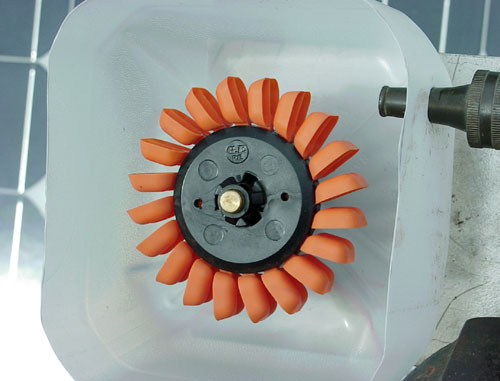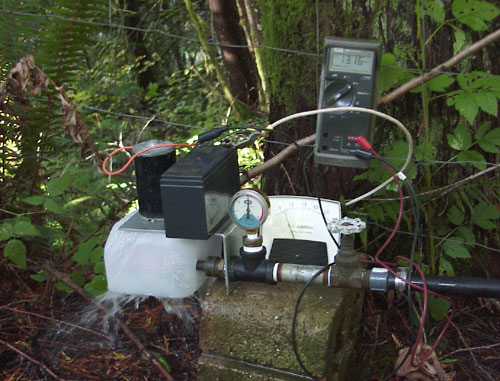Hydro Power
The days are getting shorter and darker and I find myself having to use the AC-to-DC converter in the Housetruck to keep the batteries from getting too low each night due to the current draw of the incandescent lights. This really isn't a lot of power, but it irks me to have to purchase utility power when there is so much renewable energy flowing all around me.
To wit: I dug out a project from 12 -15 years ago (maybe longer) and completed it (finally):

It's a tiny hydro power generator, constructed out of junk box parts! The generator is a permanent magent DC motor that I purchased back in 1993 to power the circulating pump on my solar heated hot tub. The other motor I purchased at the same time actually got used, this one got put on the shelf. Some years back, I bent up some scrap aluminum and mounted the motor, laying out the position of the nozzle, etc.
The Pelton runner is quite a piece of work:

This is the guts from a car washing wand that I adapted to fit on the shaft of the motor using a coupling. The washer had concentric brushes, the internal brush was rotated by water pressure provided by the garden hose. Obviously, I needed a more rugged mounting and a bigger nozzle, so I pitched the wand and housing and built my own, using the bottom of a one gallon water jug for a deflector shield.
This time of year, it's necessary for me to run the water for an hour or so every day before bathing to flush out the sediment that builds up in the pipe running down from the spring. I haven't quite figured out why water standing stationary in the pipe gets murky and running it regularly prevents this, but if I don't run the water, I end up with mud coming out the fixtures in the house.
I've always wanted to capture the energy of the flowing water, but never got much farther than my half-finished hydro generator. I actually toyed with it some the summer before last, but it made so little power that I failed to get enthused about it and it went back into storage.
A couple of days ago, I brought it out again, and over the last few evenings, I finished installing the nozzle (an old bronze high pressure hose fitting) and a valve and pressure gauge. This afternoon, I modified the water system at the house to allow me to install the small plant so that it receives pressure directly from the pipe coming up the hill from the lower pasture. I threw together an ammeter and connected a small gel cell battery as a load, and turned on the water:

I was hoping for at least an ampere at 12 volts. All I got was .6 amps. Still, this is better than nothing, so I ran some extension cords back to the Housetruck and before it got dark, connected the output of the generator to the nickle-cadmium batteries that power the Housetruck's lighting system. Turning on the water got me .73 amperes, a whopping 10 watts! I'm not complaining, 10 watts is more than the $13,000 worth of solar equipment out in the yard is producing right now. In fact, yesterday was a rainy and dreary day, and I managed to generate only 17 watt-hours with the solar system.
So, improvements: The pipe coming down from the spring is only ¾" in diameter. It has 50 pounds of static pressure. When the hydro is running the pressure at the nozzle is 15 pounds. Obviously, a bigger pipe would allow me to open up the flow considerably, which would raise the power output dramatically. Unfortunately, putting in a new pipe to the spring is not a trivial task, and is one that will have to wait for another day. The "grand plan" is to put in a pair of 2" poly pipes and start consuming more of the estimated 125 gallons per minute that the spring gushes out in the winter. When those pipes are in place, the tiny home-built hydro will be replaced with a small commercial unit that is capable of 2,000 watts of output (given enough water).
In the short term, I could boost output from this plant by moving it down to the lower pasture and running the power back to the Housetruck on long wires. The house has 50 PSI of static pressure, while the lower pasture has 75 PSI, and has about 250 feet less pipe, and fewer joints, turns and valves to impede the flow. The catch in this plan is that the pipe I'm running the hydro from is also the domestic water supply for the house and Housetruck. When the hydro is running, the pressure at the fixtures is pretty pathetic. Some means of shutting off the hydro would need to be fabricated that would allow it to be remotely started and stopped for showers, dish washing and laundry. Oboy, another project.
Normally after installing a small hydro plant, the output of the generator is optimized by "tuning" the system. Alternator-based generating systems will have a field control that would allow the maximum amout of power to be withdrawn from the alternator, essentially a "throttle" which allows the operator to trade off runner speed versus available torque. A simple permanent magnet motor has no method of controlling the magnetic flux in the field magnets, so it just runs at whatever speed the load (batteries) slow it down to.
Another method of tuning is to change the size of the nozzle. In my case, the high pressure nozzle has a 3/16" hole in the end. This may or may not be optimal for my conditions. A smaller nozzle will restrict the flow, but cause the escaping jet of water to have greater velocity, possibly spinning the Pelton wheel faster. On the other hand, this generator hits maximum output long before the valve that controls the water is fully opened. It could be that a greater volume of water at a lower speed will produce more current.
Tomorrow, I'll stop in at the hardware store in town and see what options I might have for changing the nozzle to something else, perhaps a cheap plastic nozzle that I can drill out and throw away if it doesn't work better. Commercial small hydro plants sometimes use "Rain Bird" sprinkler nozzles, which screw into a threaded fitting. Having a small collection of these might allow tuning.
If I get very bored, there is the possibility of installing one or more additional nozzles.
Moving the nozzle closer to the turbine might help some, the distance in this unit was simply what the parts on hand allowed me to put together. When I messed around with this project last year, I found that the proximity and position of the nozzle didn't make a lot of difference in the output power.
My impression is that the durability of this hydro plant is probably pretty poor. The motor has only sleeve bearings and the brushes aren't likely to last for a very long time. The plastic Pelton runner will certainly erode from the sediment in the water. Even the commercial runners made of silicon bronze wear out over the course of a few years. If the whole thing holds together for a month, I'd be surprised, but if it gets me hooked on water power, I can always step up to a more robust machine in the future (once the money starts rolling in, that is).
At any rate, the plant is running right now, contributing about two thirds of the power needed to light my desk lamp. I used incandescent lights in the kitchen while cooking dinner and didn't bother turning on the AC converter. By bedtime, I'll have consumed 5 or 6 ampere hours out of the battery, which is a very low value compared with a normal night's consumption. Overnight, the hydro plant will charge the batteries back up, perhaps fully. If that is the case, the 12 volt system solar panels won't need to see much if any sun tomorrow. Yay!
Original material ©1996-2025 Mr. Sharkey | All rights reserved
